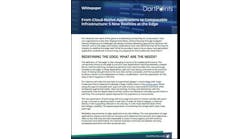The ongoing wave of data center acquisitions is enabling the industry’s big players to get even bigger. Ken Parent believes this trend creates opportunities for smaller providers.
“The choices are really dwindling,” said Parent, the CEO of the newly-rebranded Element Critical. “We live in a world where one size doesn’t fit all, and the combination of data center elements change more frequently than ever before.”
Element Critical, previously known as Central Colo, is an expansion-minded data center provider backed by global investment firm Safanad Capital and San Francisco private equity firm Industry Capital. Parent, who was previously CEO of ByteGrid, sees the opportunity to build a national platform of data centers by using a sale/leaseback strategy to buy facilities with existing tenants and available expansion space.
The company currently operates just two data centers. But Parent says Element Critical hopes to acquire up to $1 billion of data centers. “We’re going to acquire at least one more asset this year,” he said. “We’ve been building out our team and platform for a number of months. We want people to know we’re here.”
Central Colo got its start in Silicon Valley, where founder Arman Khalili bought and upgraded a former Level 3 facility in Sunnyvale. Safanad invested in Central Colo in mid-2016, and brought in Parent as the new CEO. Last December Central Colo entered the Northern Virginia data center market by acquiring the Tyson Technology Center in Vienna, which includes a 200,000-square foot Tier 3 data center and an 80,000-square foot office building, and is 75 percent leased.
Growth Through Sale/Leaseback
During his tenure at ByteGrid, Parent specialized in acquiring data centers with an existing tenant and vacant space, typically using a sale/leaseback model that provided a combination of recurring revenue and upside from leasing vacant space. That’s the model the company employed in its deal for the Tyson property, and Element Critical is searching for similar opportunities in other markets.
“Most of the M&A activity has involved bigger portfolios,” said Parent. “There are still quality assets out there, but you have to take the time to identify them.”
Jason Green, the CTO of Element Critical, said the company is building a team that can optimize each facility.
“We’re trying to capitalize on Ken’s ability to identify real estate assets with a unique profile,” said Jason Green, the CTO of Element Critical. “We look at each facility in terms of its attributes, and how we manage the capital. We’ve got staff at each facility that can get space ready and speed up our timelines with the (construction) trades.”
Seeing A Smaller Sweet Spot
On the customer side, Element Critical isn’t chasing the hyperscale deals.
“I think we have a different value proposition,” said Parent. “The sweet spot for us is 50kW to 1 megawatt. We feel that this segment of the market is underserved, particularly in a market like Northern Virginia.”
Power density is one area where Parent believes Element Critical has the flexibility to serve a range of requirements.
“We’re designing solutions ranging from a customer moving a lab into a data center for the first time to hyperscale Artificial Intelligence companies requiring liquid cooling for their 30-45 kW racks. We’ve assembled an impressive roster of industry veterans who possess the vision necessary to execute upon a simple proposition – translate data center requirements into custom solutions for less than the big box providers.”
In the past year, Element Critical strengthened its sales, operations and finance organizations, and filled key leadership positions on the executive team, including Jason Green as CTO and Bryan Chong as Senior Vice President of Sales and Marketing.






